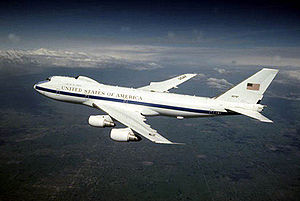
The Boeing E-4 Advanced Airborne Command Post, with the project name "Nightwatch",
Two of the original 747-200 airframes were originally planned to be commercial airliners. When the airline did not complete the order, Boeing offered the airframes to the United States Air Force as part of a package leading to a replacement for the older EC-135J National Emergency Airborne Command Post (NEACP). Under the 481B NEACP program the Air Force Electronic Systems Division awarded Boeing a contract in February 1973 for two unequipped aircraft, designated E-4A, powered by four P&W JT9D engines, to which a third aircraft was added in July 1973. The first E-4A was completed at the Boeing plant outside Seattle, Washington in 1973. E-Systems won the contract to install interim equipment in these three aircraft, and the first completed E-4A was delivered to Andrews AFB, Maryland in December 1974. The next two were delivered in 1975, the third differed by being powered by the GE F103 engine, which was later made standard and retrofitted to the previous two aircraft. The "A" model effectively housed the same equipment as the EC-135, but offered more space and an ability to remain aloft longer than an EC-135.